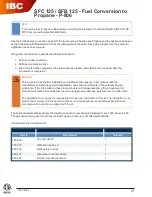
420010970304 - LP-700 Rev. 000 Rel. 002 Date 4.21.21
7
E. Boiler System
•
Thoroughly flush the system (without the boiler connected)
to remove sediment. The high-efficiency heat exchanger can
be damaged by build-up or corrosion due to sediment. The
manufacturer recommends a suction strainer in this type of
system.
•
Do not use petroleum-based cleaning or sealing compounds
in boiler system. Gaskets and seals in the system may be
damaged, possibly resulting in substantial property damage.
•
Do not use “homemade cures” or “boiler patent medicines”.
Substantial property damage, damage to the boiler, and/or
serious personal injury may result.
•
Continual fresh make-up water will reduce boiler life.
Mineral buildup in the heat exchanger reduces heat transfer,
overheats the stainless steel heat exchanger, and causes
failure. Addition of oxygen from make-up water can cause
internal corrosion in system components. Leaks in the boiler
or piping must be repaired at once.
NOTE: DO NOT add cold make up water to the system when the
boiler is hot. Thermal shock can potentially cause cracks in the heat
exchanger. Such damage IS NOT covered by warranty.
•
Do not use petroleum-based cleaning or sealing compounds
in boiler system. Gaskets and seals in the system may be
damaged, possibly resulting in substantial property damage.
•
Do not use “homemade cures” or “boiler patent medicines”.
Substantial property damage, damage to boiler, and/or
serious personal injury may result.
•
Always verify proper operation after servicing the boiler.
NOTE: When inquiring about service or troubleshooting, reference
the model and serial numbers from the boiler rating label.
F. CH and DHW Loop Water Chemistry Requirements
The water must be potable, free of corrosive chemicals, sand,
dirt, and other contaminates. It is up to the installer to ensure the
water does not contain corrosive chemicals or elements that can
damage the heat exchanger. Potable water is defined as drinkable
water supplied from utility or well water in compliance with EPA
secondary maximum contaminant levels (40 CFR Part 143.3). If
the water contains contaminants higher than outlined by the EPA,
water treatment is recommended and additional, more frequent
maintenance may be required. See Table 1.
If you suspect that your water is contaminated in any way, discontinue
use of the appliance and contact an authorized technician or licensed
professional.
CH Loop Total Water Hardness Specifications
Contaminant
Maximum Allowable Level
Total Hardness
120 mg/l
(7 grains/gallon)
DHW Loop Total Water Hardness Specifications
Contaminant
Maximum Allowable Level
Total Hardness
(Below 140
o
F water temperature)
200 mg/l
(12 grains/gallon)
Total Hardness
(Above 140
o
F water temperature)
120 mg/l
(7 grains/gallon)
CH and DHW Loop Water Quality Specifications
Contaminant
Maximum Allowable Level
Aluminum
0.05 to 0.2 mg/l or PPM
Chloride
100 mg/l or PPM
Copper
1 mg/l or PPM
Iron
0.3 mg/l or PPM
Manganese
0.05 mg/l or PPM
pH
6.5 - 8.5
Sulfate
205 mg/l or PPM
Total Dissolved Solids (TDS)
500 mg/l or PPM
Zinc
5 mg/l or PPM
Dissolved Carbon Dioxide (CO2)
15 mg/l or PPM
Table 1 - Water Quality Specifications
CAUTION
Chemical imbalance of the water supply may affect efficiency and
cause severe damage to the boiler and associated equipment.
Water quality must be professionally analyzed to determine
whether it is necessary to treat the water. Various solutions are
available to adjust water quality. Adverse water quality will affect
the reliability of the system. In addition, operating temperatures
above 135
o
F will accelerate the build-up of lime scale and possibly
shorten boiler service life. Failure of a boiler due to lime scale build-
up, low pH, or other chemical imbalance IS NOT covered by the
warranty.
G. Freeze Protection
WARNING
!
NEVER use any toxic chemical, including automotive, standard
glycol antifreeze, or ethylene glycol made for hydronic (non-
potable) systems. These chemicals can attack gaskets and seals in
water systems, are poisonous if consumed, and can cause personal
injury or death.
CAUTION
Consider piping and installation when determining boiler location.
Damages resulting from incorrect installation or from use of
products not approved by the manufacturer ARE NOT covered by
warranty. Failure of the boiler due to freeze related damage IS NOT
covered by product warranty.
NOTE: Loops Serving Indirect Water Heaters (IWHs)
Glycol used in IWH loops should be food grade propylene glycol,
FDA rated as “generally recognized as safe” (GRAS). If using a glycol /
potable water mix, the water chemistry must meet the requirements
in this manual. The glycol content of the liquid must not exceed 50%,
unless the manufacturer specifies a different ratio. Glycol should be
checked periodically to prevent it from becoming acidic. Please refer
to guidelines provided by the glycol manufacturer regarding glycol
maintenance.
NOTE: Glycol not recognized as GRAS may only be used in closed
loop CH applications.
NOTE: HTP DOES NOT WARRANT THE BOILER AGAINST FREEZE-
RELATED DAMAGE.
The boiler control is equipped with freeze protection that activates
based on internal water temperature. See the following table for
details on freeze protection operation.
NOTE: Freeze protection will not be active if the boiler loses power.








































